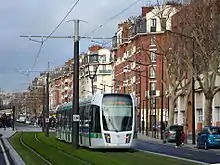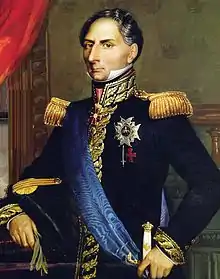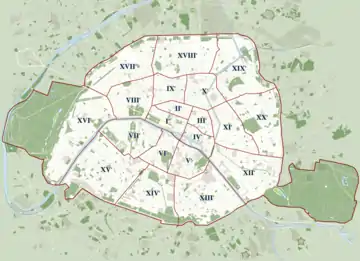Boulevards of the Marshals
The Boulevards of the Marshals (French: Boulevards des Maréchaux) are a collection of thoroughfares that encircle the city of Paris, France, just inside its city limits. Most bear the name of a marshal of the First French Empire (1804–1814) who served under Napoleon I. The Île-de-France tramway Lines 3a and 3b today run on the Boulevards of the Marshals.



The demolition of the Thiers wall during the 1920s allowed for the creation of this ring of boulevards surrounding the city, using the land just inside the wall itself. Later, the Boulevard Périphérique, a short distance 'outboard' of the Boulevards of the Marshals, was built on the site of the Thiers wall itself, though it is more like a motorway than a wide boulevard.
History
.jpeg.webp)
The Boulevards of the Marshals occupy the route of the former Rue Militaire, built and owned by the French military and running on the inside of the fortified Thiers wall, completed around 1840. In 1859, the military engineering service gave conditional control of the Rue Militaire and Thiers wall to the Paris city council.[1] The expansion of the land area of Paris in 1860, by annexing bordering communities, created a situation where everything within the Thiers wall was Paris and everything without was not. The large berm immediately outside the wall and its dry moat led to a profound disruption and complication of the synergistic relationship between Paris and its suburbs.
In the 1920s, the dismantling of the enclosure permitted the building of a series of boulevards encircling the city, in the same way that the destruction of the wall of Louis XIII had eventually given birth, at the end of the 17th century, to the great boulevards of the right bank. This also served to re-integrate, to a large extent, Paris with its hinterland.
The Boulevards of the Marshals concept was almost fully realized by 1932, but the section known as Boulevard Amiral Bruix (an admiral rather than a marshal) was not incorporated until 1987. The Boulevard du General Martial Valin, a general of the World War II Free French air corps, and the Boulevard du General Jean Simon, another officer of the Free French and a hero of the liberation of Paris, were not added to the circle until 2005.
Exceptions
Three of the boulevards are named for famous military leaders who were not amongst the 26 marshals of the First Empire: Étienne Eustache Bruix (1759–1805), a French admiral; Jean Simon (1912–2003), a distinguished general of the French Foreign Legion; and Martial Henri Valin (1898–1980), an air force general.

Of the 26 marshals of the First Empire, seven have not been immortalized by having their names attached to boulevards comprising the ring. These 'missing' marshals – Pierre Augereau, Jean-Baptiste Bernadotte, Emmanuel de Grouchy, Auguste de Marmont, Bon-Adrien Jeannot de Moncey, Nicolas Oudinot, and Catherine-Dominique de Pérignon – had been relieved, during their lifetime, of the honor of Marshal of the Empire after having disputes with Napoleon or by changing sides during the periods when Napoleon was in exile, during the Hundred Days, during the Bourbon Restoration, or becoming royalty of an enemy (Bernadotte become Crown Prince of Sweden in 1810, and led Swedish forces within the coalition that defeated Napoleon in 1814).
Of the seven marshals without a boulevard, Bernadotte, Marmont, and Grouchy are considered "traitors to France", while the remaining four have streets (rather than boulevards) named for them: Rue Augereau in the 7th arrondissement, Rue Moncey in the 9th, Rue Oudinot in the 7th, and the Rue Pérignon, which traverses the 7th and 15th arrondissements.
There is a slight discontinuity in the loop around the city near the Garigliano Bridge: between the Boulevard du Général-Martial-Valin, in the 15th arrondissement, and Boulevard Murat in the 16th. On the right-bank side of the Garigliano Bridge (16th arrondissement), one may take the Quai Saint-Exupéry a little more than a hundred meters to meet the Boulevard Exelmans, which leads to Boulevard Murat, or, if one chooses to continue on Exelmans, one will meet the Boulevard Suchet near Porte d'Auteuil. Technically, the Boulevard Exelmans is not part of the Boulevards of the Marshals; he, Rémi Joseph Isidore Exelmans, was aide-de-camp to Marshal Murat during the First-Empire period, but he became a marshal in his own right during the Second Empire (1851).
In the 19th arrondissement, the Boulevard d'Indochine and the Boulevard d'Algérie follow the contour of Paris more closely than the Boulevards of the Marshals by avoiding a portion of the Boulevard Sérurier.
List of boulevards

Below is a list of the boulevards in Paris named after marshals of France. The list starts at the Porte de Vincennes and continues in ascending numerical order of arrondissements, from the 12th to the 20th; in effect, around Paris in clockwise fashion, beginning from the 3:00 position. Also noted are the connections to the Paris Métro, the Réseau Express Régional (RER), the Paris Tramway Line 3, the city gates of Paris, and the main roads leaving the capital for adjacent communes.
Legend:
| : métro station, line 1. | |
| : RER station, line B. | |
| : tramway stop, line 3. |
| Arrondissement | Boulevard | Porte | Trunk roads | Border communes |
|---|---|---|---|---|
| 12th | Boulevard Soult | Porte de Vincennes – |
Saint-Mandé | |
| Porte de Saint-Mandé | ||||
| Porte de Montempoivre | ||||
| Porte Dorée – | ||||
| Boulevard Poniatowski | Bois de Vincennes | |||
| Porte de Reuilly | ||||
| Porte de Charenton – |
||||
| Charenton-le-Pont | ||||
| Porte de Bercy | ||||
| Seine | Pont National | |||
| 13th | Boulevard du Général-Jean-Simon | Porte de la Gare | Ivry-sur-Seine | |
| Porte de Vitry | ||||
| Boulevard Masséna | ||||
| Porte d'Ivry – | ||||
| Porte de Choisy – |
||||
| Porte d'Italie – |
Le Kremlin-Bicêtre | |||
| Boulevard Kellermann | ||||
| Poterne des Peupliers – |
Gentilly | |||
| Porte de Gentilly – |
||||
| 14th | Boulevard Jourdan | |||
| Porte d'Arcueil – | ||||
| Montrouge | ||||
| Porte d'Orléans – |
||||
| Boulevard Brune | ||||
| Porte de Montrouge | ||||
| Porte de Châtillon – | ||||
| Malakoff | ||||
| Porte Didot – | ||||
| Porte de Vanves – | ||||
| 15th | Boulevard Lefebvre | Porte Brancion – |
Vanves | |
| Porte de Plaisance et Porte de la Plaine – | ||||
| Porte de Versailles – |
Issy-les-Moulineaux | |||
| Boulevard Victor | ||||
| Porte d'Issy-les-Moulineaux – | ||||
| Porte de Sèvres – | ||||
| Boulevard du Général-Martial-Valin | ||||
| Seine | Pont du Garigliano | |||
| 16th | Bois de Boulogne | Porte de Boulogne | Boulogne-Billancourt | |
| Porte de l'Hippodrome | ||||
| Porte de la Seine | ||||
| Porte de Madrid | ||||
| Porte Saint-James | ||||
| Porte de Neuilly | ||||
| Porte des Sablons | ||||
| Boulevard Murat | Porte du Point-du-Jour | Boulogne-Billancourt | ||
| Porte de Saint-Cloud – |
||||
| Porte Molitor – |
||||
| Bois de Boulogne | ||||
| Porte d'Auteuil – |
||||
| Boulevard Suchet | ||||
| Porte de Passy | ||||
| Porte de la Muette | ||||
| Boulevard Lannes | ||||
| Porte Dauphine – | ||||
| Boulevard de l'Amiral-Bruix | ||||
| Porte Maillot – |
||||
| 17th | Boulevard Gouvion-Saint-Cyr | Neuilly-sur-Seine | ||
| Porte des Ternes | ||||
| Porte de Villiers | ||||
| Levallois-Perret | ||||
| Porte de Champerret – | ||||
| Boulevard Berthier | ||||
| Porte de Courcelles | ||||
| Porte d'Asnières | ||||
| Porte de Clichy – |
Clichy | |||
| Boulevard Bessières | ||||
| Porte Pouchet | Saint-Ouen – | |||
| Porte de Saint-Ouen | ||||
| 18th | Boulevard Ney | |||
| Porte Montmartre | ||||
| Porte de Clignancourt – |
||||
| Porte des Poissonniers | ||||
| Saint-Denis | ||||
| Porte de la Chapelle – |
||||
| Porte d'Aubervilliers | Aubervilliers | |||
| 19th | Boulevard Macdonald | |||
| Canal Saint-Denis | ||||
| Porte de la Villette – |
||||
| Pantin | ||||
| Canal de l'Ourcq | ||||
| Boulevard Sérurier | ||||
| Porte de Pantin – |
||||
| Le Pré-Saint-Gervais | ||||
| Porte Chaumont | ||||
| Porte Brunet | ||||
| Porte du Pré-Saint-Gervais – | ||||
| Porte des Lilas – | ||||
| 20th | Boulevard Mortier | Les Lilas | ||
| Porte de Ménilmontant | Bagnolet | |||
| Porte de Bagnolet – |
||||
| Boulevard Davout | ||||
| Porte de Montreuil – |
Montreuil | |||
| Porte de Vincennes – | ||||
| Saint-Mandé | ||||
Transportation
The boulevards are, of course, city streets and open to vehicular traffic. They do not constitute an expressway or limited-access motorway in the fashion of the Boulevard Périphérique; the speed limit on the boulevards is generally 50 km/h.
There are also bus lanes separated from the normal lanes of traffic, and a bicycle path on the sidewalk has been installed. The Paris Tramway Line 3 (Ile-de-France) follows the boulevards of the marshals along the southern edge of the city.
Places of interest
Some specific sites near the boulevards are:
- Bois de Boulogne
- Bois de Vincennes and the Throne carnival
- Cité Internationale Universitaire de Paris
- City of Science and Industry
- Heliport de Paris - Issy-les-Moulineaux
- Hôpital Européen Georges-Pompidou
- Robert Debré Pediatric Hospital
- Marmottan Museum
- Palais des Sports de Paris
- Parc André Citroën
- Parc de la Butte du Chapeau-Rouge
- The Fairgrounds at the Versailles gate
- Parc Georges Brassens
- Parc Kellermann
- Parc Montsouris
- Parc des Princes
- Stade Charlety
References
- Deville, A. (Adrien); Hochereau, (Émile) (1886). "Rue Militaire (28 juillet 1859)". In Alphand, Monsieur (Jean-Charles Adolphe) (ed.). Ville de Paris : Recueil des Lettres Patentes, Ordonnances Royales, Décrets et Arrêtés Préfectoraux Concernant les Voies Publiques [City of Paris. Collection of letters patents, royal ordinances, decrees and prefectores relating to public roads.] (in French). Paris: Imprimerie Nouvelle (Association Ouvrière). pp. 314–315. Retrieved 2020-08-12.
See also
- Ring road
- City gates of Paris
- Louis Alexandre Berthier
- Jean-Baptiste Bessières
- Guillaume Marie Anne Brune
- Louis-Nicolas Davout
- Laurent de Gouvion Saint-Cyr
- Jean-Baptiste Jourdan
- François Christophe de Kellermann
- Jean Lannes
- François Joseph Lefebvre
- Jacques MacDonald
- André Masséna
- Édouard Adolphe Casimir Joseph Mortier
- Joachim Murat
- Michel Ney
- Józef Antoni Poniatowski
- Jean-Mathieu-Philibert Sérurier
- Jean-de-Dieu Soult
- Louis Gabriel Suchet
- Claude Victor-Perrin, Duc de Belluno